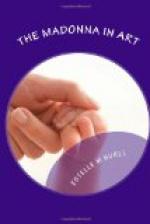The Castel-Franco picture expresses the finest elements in Venetian character. Every other composition seems elaborate and artificial when compared with the simplicity of this. Other Madonnas seem almost coarse beside such delicacy. The Virgin’s throne is of an unusual height,—a double plinth,—the upper step of which is somewhat above the heads of the attendant saints, Liberale and Francis. This simple, compositional device emphasizes the effect of her pensive expression. It is as if her high meditations set her apart from human companionship. There is, indeed, something almost pathetic in her isolation, but for the strength of character in her face. The color scheme is as simple and beautiful as the underlying conception. The Virgin’s tunic is of green, and the mantle, falling from the right shoulder and lying across her lap, is red, with deep shadows in its large folds. The back of the seat is covered with a strip of red and gold embroidery.
The later period of Venetian art is marked by a new ideal of the Virgin. She is now a magnificent creature of flesh and blood. Her face is proud and handsome; her figure large, well-proportioned, and somewhat voluptuous. No Bethlehem stable ever sheltered this haughty beauty; her home is in kings’ palaces; she belongs distinctly to the realm of wealth and worldliness. She has never known sorrow, anxiety, or poverty; life has brought her nothing but pleasure and luxury. Her throne stands no longer in the sacred place of some inner sanctuary, where angel choristers make music. It is an elevated platform, at one side of the composition, as in Titian’s Pesaro altar-piece, and Veronese’s Madonna in the Venice Academy. This gives an opportunity for a display of elaborate draperies, such as we may see in Veronese’s picture.
The peculiar qualities of art in Verona and Venice are blended in Paolo Veronese. No artist ever enjoyed more the splendors of color, or combined them in more enchanting harmonies. Such gifts transform the commonest materials, and, though his Virgin is a very ordinary woman, she has undeniable charms. An oft-copied figure, in this picture, is that of the little St. John, a universal favorite among child lovers.
[Illustration: VERONESE.—MADONNA AND SAINTS.]
The reader must have remarked that, though the fundamental idea of the enthroned Madonna is that of queenship, the Virgin wears no crown in any of the pictures thus far cited; the crowned Madonna is not characteristic of Italian art. It is found occasionally in mosaics from the eighth to the eleventh centuries, and in some of the early votive pictures, but does not appear in the later period except in a few Venetian pictures by Giovanni da Murano and Carlo Crivelli. The same idea was often carried out by placing two hovering angels over the Virgin’s head, holding the crown between them. Botticelli’s Madonna of the Inkhorn is treated in this way.




